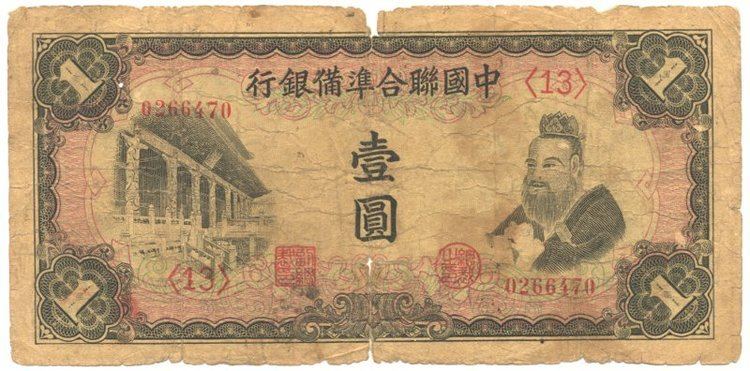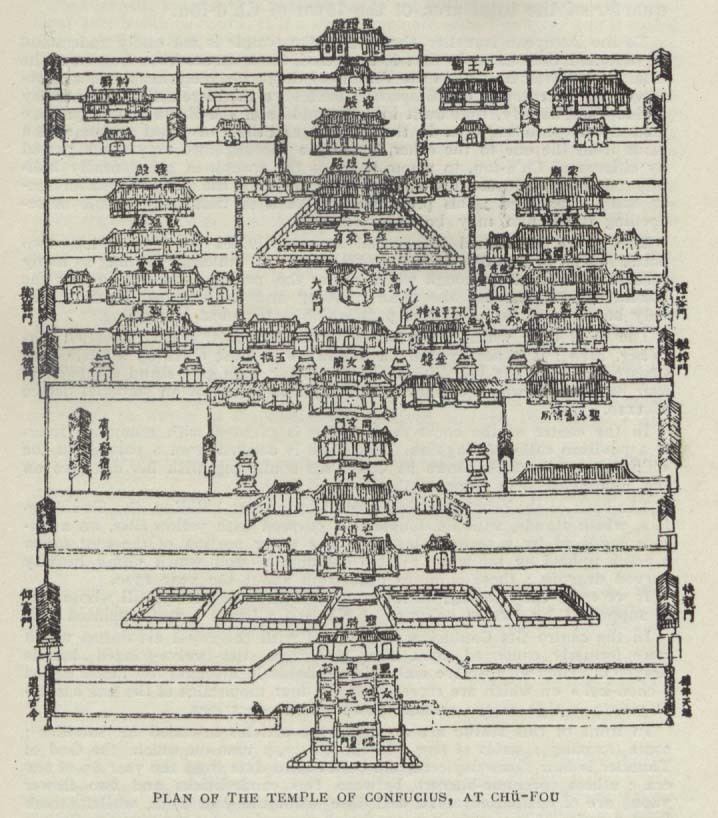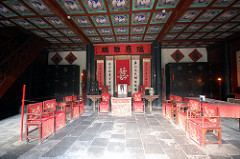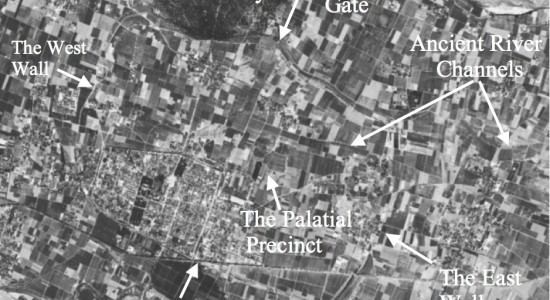Area 896 km² Population 625,313 (2000) | ||
Country Peoples Republic of China University Qufu Normal University | ||
Qufu (Chinese: ; pinyin: ; Wade–Giles: ) is a city in the south-west of Shandong province, Peoples Republic of China. It is located at 35° 36? northern latitude and 117° 02? east, about 130 kilometres (81 mi) south of the provincial capital Jinan and 45 kilometres (28 mi) northeast of the prefecture seat at Jining. Qufu has an urban population of about 60,000, the entire administrative region has about 650,000 inhabitants.
Contents
- Map of Qufu
- Birth place of confucius kong qiu qufu china
- History
- Geography
- Economy
- Philippine cuisine
- References
Map of Qufu
Qufu is the hometown of Confucius, who is traditionally believed to have been born at nearby Mount Ni. The city contains numerous historic palaces, temples and cemeteries. The three most famous cultural sites of the city, collectively known as San Kong (??), i.e. "The Three Confucian [sites]", are the Temple of Confucius (Chinese: ; pinyin: ), the Cemetery of Confucius (Chinese: ; pinyin: ), and the Kong Family Mansion (Chinese: ; pinyin: ). Together, these three sites have been listed as a UNESCO World Heritage Site since 1994.
Birth place of confucius kong qiu qufu china
History

Qufu served as the capital of the State of Lu during the Spring and Autumn Period. The city wall of the Lu capital surrounded not only the area of todays (Ming-era) walled city, but also a significant territory to the east and north of it.

During the Tang Dynasty and the early days of the Song Dynasty the city was centered around the present-day Temple of Duke Zhou, at the northeastern corner of todays walled city. At 1012, Qufu was renamed to Xianyuan County (???), and relocated to the new site, some 4 km east of todays walled city, next to the supposed birthplace of the legendary Yellow Emperor and the tomb of his son Shaohao. A temple in honor of the Yellow Emperor was built there; all that remains today are two giant stelae (the Shou Qiu site).
After the conquest of the northern China by the Jurchens, the new Jin Dynasty renamed Xianyuan back to Qufu (in 1142), but the city stayed at its Song location. It was not until the reign of the Jiajing Emperor of the Ming Dynasty (1522) that the present-day city wall was built. The site of the city in 1012-1522 is now Jiuxian Village (???).
In 1948, Qufu played a minor role in the Yanzhou Campaign of the Chinese Civil War.
The artifacts of the historical sites at Qufu suffered extensive damage during the Cultural Revolution when about 200 staff members and students of Beijing Normal University led by Tan Houlan (???, 1937–1982), one of the five most powerful student leaders of the Cultural Revolution, came to Qufu and destroyed more than 6000 artifacts in November 1966.
Before the wide adoption of Pinyin, the name of the city (often viewed as a county seat, i.e. Qufu xian) was transcribed in English in a variety of ways, such as Chu-fou-hien, Kio-feu-hien, Kio-fou-hien, Kiu-fu, Kiuh Fow, Keuhfow, Kufow, and Chufou.
Geography

The small historical center of Qufu is surrounded by the restored Ming-era city wall and rivers/moats. The Drum Tower (Gulou) is in the center of the walled city; the Temple of Confucius (Kong Miao), Confucius Mansion (Kong Fu) and the Temple of Yan Hui (Yan Miao) occupy large sections of the land within the wall.

The Confucius Cemetery (Kong Lin) is located 1.3 km to the north of the walled city. The modern downtown is located south of the walled city. There is also a mosque and a thriving Muslim neighborhood and market that is located just outside the west gate of the walled city.
The Qufu train station and major industrial areas are on the east side, a few kilometers east of the historical city. The Shaohao Tomb (Chinese: ; pinyin: ) and Shou Qiu historical site (Chinese: ; pinyin: , the purported birthplace of the legendary Yellow Emperor), are on the eastern outskirts of the modern Qufu as well, near Jiuxian village.
Economy
Qufus economy is based primarily on agriculture and grain production. The other main industries are food processing, textile, construction materials, chemical, coal mining, pharmacy, paper making and industrial machinery.
Philippine cuisine
Philippine cuisine consists of the food, preparation methods and eating customs found in the Philippines. The style of cooking and the food associated with it have evolved over many centuries from its Austronesian origins to a mixed cuisine of Malay, Spanish, Chinese, and American, as well as other Asian and Latin influences adapted to indigenous ingredients and the local palate.
Dishes range from the very simple, like a meal of fried salted fish and rice, to the elaborate paellas and cocidos created for fiestas of Spanish origin, and spaghetti and lasagna of Italian origin. Popular dishes include: lechon (whole roasted pig), longganisa (Philippine sausage), tapa (cured beef), torta (omelette), adobo (chicken and/or pork braised in garlic, vinegar, oil and soy sauce, or cooked until dry), kaldereta (meat in tomato sauce stew), mechado (larded beef in soy and tomato sauce), puchero (beef in bananas and tomato sauce), afritada (chicken and/or pork simmered in a peanut sauce with vegetables), kare-kare (oxtail and vegetables cooked in peanut sauce), pinakbet (kabocha squash, eggplant, beans, okra, and tomato stew flavored with shrimp paste), crispy pata (deep-fried pigs leg), hamonado (pork sweetened in pineapple sauce), sinigang (meat or seafood in sour broth), pancit (noodles), and lumpia (fresh or fried spring rolls).
During the pre-Hispanic era in the Philippines, the preferred Austronesian methods for food preparation were boiling, steaming and roasting. The ingredients for common dishes were obtained from locally raised livestock. These ranged from kalabaw (water buffaloes), baka (cows), manok (chickens) and baboy (pigs) to various kinds of fish and seafood. In 3200 BCE, Austronesians from the southern China Yunnan-Guizhou Plateau and Taiwan settled in the region that is now called the Philippines. They brought with them knowledge of rice cultivation and other farming practices which increased the number and variety of edible dish ingredients available for cooking.
Direct trade and cultural exchange with Hokkien China in the Philippines in the Song dynasty (960–1279 AD) with porcelain, ceramics, and silk being traded for spices and trepang in Luzon. This early cultural contact with China introduced a number of staple food into Philippine cuisine, most notably toyo (soy sauce; Chinese: ; Pe?h-oe-ji: ), tokwa; (tofu; Chinese: ; Pe?h-oe-ji: ), toge (bean sprout; Chinese: ; Pe?h-oe-ji: ), and patis (fish sauce), as well as the method of stir frying and making savory soup bases. Many of these food items and dishes retained their original Hokkien names, such as pancit (Chinese: ; Pe?h-oe-ji: )(Chinese: ; pinyin: ), and lumpia (Chinese: ; Pe?h-oe-ji: ). The Chinese food introduced during this period were food of the workers and traders, which became a staple of the noodle shops (panciterias), and can be seen in dishes like arroz caldo (congee), sinangag (fried rice), chopsuey.
